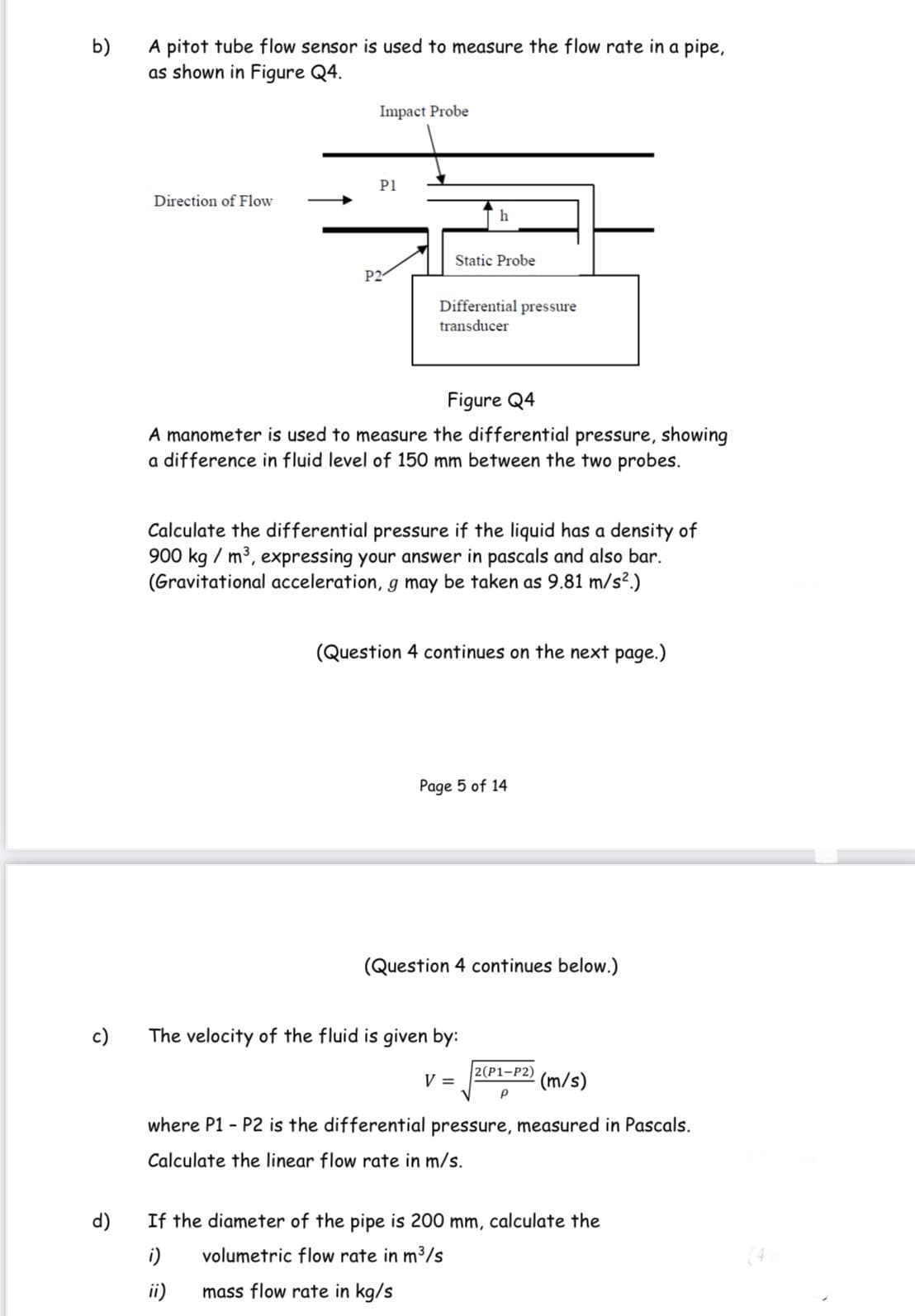A pitot tube flow sensor is used to measure the flow rate in a pipe, as shown in Figure Q4.
A pitot tube flow sensor is used to measure the flow rate in a pipe, as shown in Figure Q4.
Elements Of Electromagnetics
7th Edition
ISBN:9780190698614
Author:Sadiku, Matthew N. O.
Publisher:Sadiku, Matthew N. O.
ChapterMA: Math Assessment
Section: Chapter Questions
Problem 1.1MA
Related questions
Question

Transcribed Image Text:b)
A pitot tube flow sensor is used to measure the flow rate in a pipe,
as shown in Figure Q4.
Impact Probe
P1
Direction of Flow
Static Probe
P2
Differential pressure
transducer
Figure Q4
A manometer is used to measure the differential pressure, showing
a difference in fluid level of 150 mm between the two probes.
Calculate the differential pressure if the liquid has a density of
900 kg / m3, expressing your answer in pascals and also bar.
(Gravitational acceleration, g may be taken as 9.81 m/s².)
(Question 4 continues on the next page.)
Page 5 of 14
(Question 4 continues below.)
c)
The velocity of the fluid is given by:
2(P1-P2)
V =
(m/s)
where P1 - P2 is the differential pressure, measured in Pascals.
Calculate the linear flow rate in m/s.
d)
If the diameter of the pipe is 200 mm, calculate the
i)
volumetric flow rate in m3/s
ii)
mass flow rate in kg/s
Expert Solution
This question has been solved!
Explore an expertly crafted, step-by-step solution for a thorough understanding of key concepts.
Step by step
Solved in 2 steps with 2 images

Knowledge Booster
Learn more about
Need a deep-dive on the concept behind this application? Look no further. Learn more about this topic, mechanical-engineering and related others by exploring similar questions and additional content below.Recommended textbooks for you

Elements Of Electromagnetics
Mechanical Engineering
ISBN:
9780190698614
Author:
Sadiku, Matthew N. O.
Publisher:
Oxford University Press

Mechanics of Materials (10th Edition)
Mechanical Engineering
ISBN:
9780134319650
Author:
Russell C. Hibbeler
Publisher:
PEARSON

Thermodynamics: An Engineering Approach
Mechanical Engineering
ISBN:
9781259822674
Author:
Yunus A. Cengel Dr., Michael A. Boles
Publisher:
McGraw-Hill Education

Elements Of Electromagnetics
Mechanical Engineering
ISBN:
9780190698614
Author:
Sadiku, Matthew N. O.
Publisher:
Oxford University Press

Mechanics of Materials (10th Edition)
Mechanical Engineering
ISBN:
9780134319650
Author:
Russell C. Hibbeler
Publisher:
PEARSON

Thermodynamics: An Engineering Approach
Mechanical Engineering
ISBN:
9781259822674
Author:
Yunus A. Cengel Dr., Michael A. Boles
Publisher:
McGraw-Hill Education

Control Systems Engineering
Mechanical Engineering
ISBN:
9781118170519
Author:
Norman S. Nise
Publisher:
WILEY

Mechanics of Materials (MindTap Course List)
Mechanical Engineering
ISBN:
9781337093347
Author:
Barry J. Goodno, James M. Gere
Publisher:
Cengage Learning

Engineering Mechanics: Statics
Mechanical Engineering
ISBN:
9781118807330
Author:
James L. Meriam, L. G. Kraige, J. N. Bolton
Publisher:
WILEY